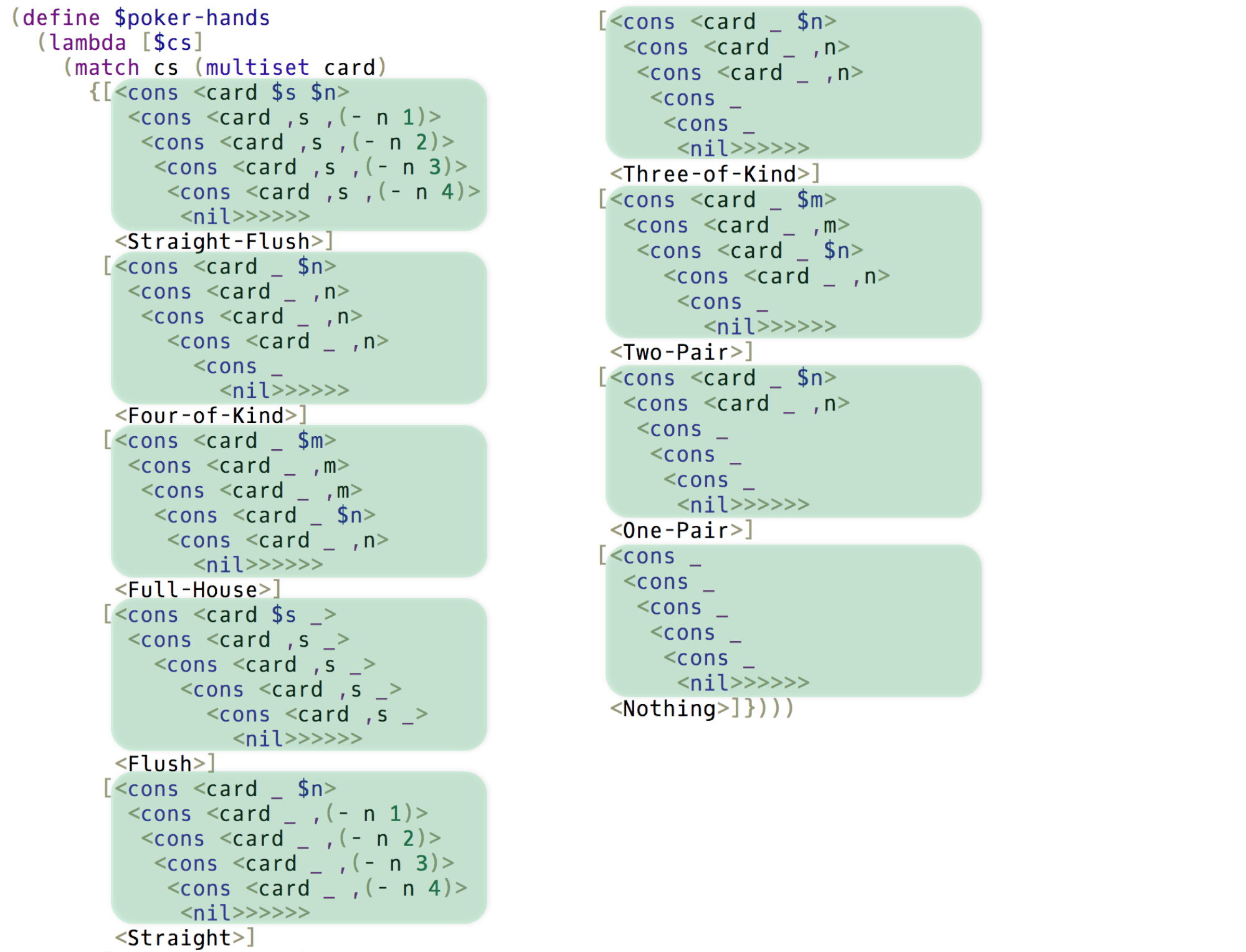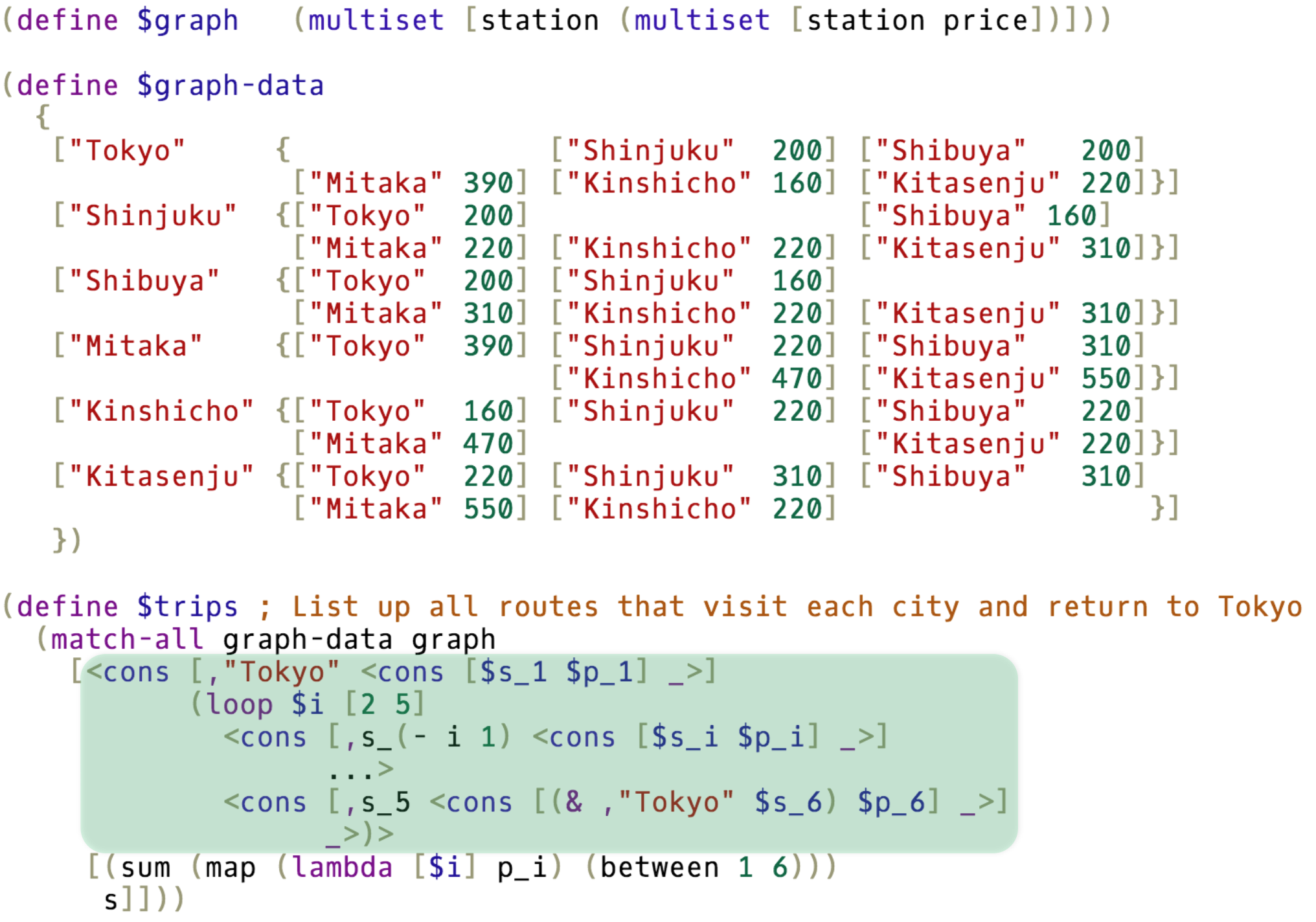The Egison Programming Language
Egison is the pattern-matching-oriented, purely functional programming language. We can directly represent pattern-matching against lists, multisets, sets, trees, graphs and any kind of data types. This is the repository of the interpreter of Egison.
For more information, visit our website.
Non-Linear Pattern-Matching against Non-Free Data Types
We can do non-linear pattern-matching against non-free data types in Egison. An non-free data type is a data type whose data have no canonical form, a standard way to represent that object. It enables us to write elegant programs.
Twin Primes
We can use pattern-matching for enumeration. The following code enumerates all twin primes from the infinite list of prime numbers with pattern-matching!
Poker Hands
The following code is the program that determines poker-hands written in Egison. All hands are expressed in a single pattern.
Mahjong
We can write a pattern even against mahjong tiles. We modularize patterns to represent complex mahjong hands.
Graphs
We can pattern-match against graphs. We can write program to solve the travelling salesman problem in a single pattern-matching expression.
Aren't these exciting? The pattern-matching of Egison is very powerful. We can use it for pattern-matching also against graphs and tree-structures such as XML.
Egison as a Computer Algebra System
As an application of Egison, we implemented a computer algebra system on Egison. The most part of this computer algebra system is written in Egison and extensible in Egison.
Symbolic Algebra
Unbound variables are treated as symbols.
> x
x
> (** (+ x y) 2)
(+ x^2 (* 2 x y) y^2)
> (** (+ x y) 10)
(+ x^10 (* 10 x^9 y) (* 45 x^8 y^2) (* 120 x^7 y^3) (* 210 x^6 y^4) (* 252 x^5 y^5) (* 210 x^4 y^6) (* 120 x^3 y^7) (* 45 x^2 y^8) (* 10 x y^9) y^10)
We can handle algebraic numbers, too.
> (sqrt x)
(sqrt x)
> (sqrt 2)
(sqrt 2)
> (sqrt 4)
2
> (+ x (sqrt y))
(+ x (sqrt y))
Complex Numbers
The symbol i is defined to rewrite i^2 to -1 in Egison library.
> (* i i)
-1
> (* (+ 1 (* 1 i)) (+ 1 (* 1 i)))
(* 2 i)
> (** (+ 1 (* 1 i)) 10)
(* 32 i)
> (* (+ x (* y i)) (+ x (* y i)))
(+ x^2 (* 2 i x y) (* -1 y^2))
Square Root
The rewriting rule for sqrt is also defined in Egison library.
> (* (sqrt 2) (sqrt 2))
2
> (* (sqrt 6) (sqrt 10))
(* 2 (sqrt 15))
> (sqrt x)
(sqrt x)
> (* (sqrt (* x y)) (sqrt (* 2 x)))
(* x (sqrt 2) (sqrt y))
The 5th Roots of Unity
The following is a sample to calculate the 5th roots of unity.
> (q-f' 1 1 -1)
[(/ (+ -1 (sqrt 5)) 2) (/ (+ -1 (* -1 (sqrt 5))) 2)]
> (define $t (fst (q-f' 1 1 -1)))
> (q-f' 1 (* -1 t) 1)
[(/ (+ -1 (sqrt 5) (sqrt (+ -10 (* -2 (sqrt 5))))) 4) (/ (+ -1 (sqrt 5) (* -1 (sqrt (+ -10 (* -2 (sqrt 5)))))) 4)]
> (define $z (fst (q-f' 1 (* -1 t) 1)))
> z
(/ (+ -1 (sqrt 5) (sqrt (+ -10 (* -2 (sqrt 5))))) 4)
> (** z 5)
1
Differentiation
We can implement differentiation easily in Egison.
> (d/d (** x 3) x)
(* 3 x^2)
> (d/d (** e (* i x)) x)
(* i (** e (* i x)))
> (d/d (d/d (log x) x) x)
(/ -1 x^2)
> (d/d (* (cos x) (sin x)) x)
(+ (* -1 (sin x)^2) (cos x)^2)
Taylor Expansion
The following sample executes Taylor expansion on Egison. We verify Euler's formula in the following sample.
> (take 8 (taylor-expansion (** e (* i x)) x 0))
{1 (* i x) (/ (* -1 x^2) 2) (/ (* -1 i x^3) 6) (/ x^4 24) (/ (* i x^5) 120) (/ (* -1 x^6) 720) (/ (* -1 i x^7) 5040)}
> (take 8 (taylor-expansion (cos x) x 0))
{1 0 (/ (* -1 x^2) 2) 0 (/ x^4 24) 0 (/ (* -1 x^6) 720) 0}
> (take 8 (taylor-expansion (* i (sin x)) x 0))
{0 (* i x) 0 (/ (* -1 i x^3) 6) 0 (/ (* i x^5) 120) 0 (/ (* -1 i x^7) 5040)}
> (take 8 (map2 + (taylor-expansion (cos x) x 0) (taylor-expansion (* i (sin x)) x 0)))
{1 (* i x) (/ (* -1 x^2) 2) (/ (* -1 i x^3) 6) (/ x^4 24) (/ (* i x^5) 120) (/ (* -1 x^6) 720) (/ (* -1 i x^7) 5040)}
Vector and Matrix
We support tesnsor algebra. We use Einstein notation to express arithmetic operations between tensors.
A vector and matrix is expressed by enclosing its elements with (| and |).
A tensor of higher order than 2 is expressed by a tensor expression whose arguments are its dimensions and elements.
(tensor <dimensions> <elements>)
> (define $V1 [| x_1 x_2 x_3 |])
> (define $V2 [| y_1 y_2 y_3 |])
> (. V1~i V2_i)
(+ (* x_1 y_1) (* x_2 y_2) (* x_3 y_3))
> (. V1~i V2_j)
[| [| (* x_1 y_1) (* x_1 y_2) (* x_1 y_3) |] [| (* x_2 y_1) (* x_2 y_2) (* x_2 y_3) |] [| (* x_3 y_1) (* x_3 y_2) (* x_3 y_3) |] |]~i_j
> (define $M1 (generate-tensor 2#x_%1_%2 {2 2}))
> (define $M2 (generate-tensor 2#y_%1_%2 {2 2}))
> M1
[| [| x_1_1 x_1_2 |] [| x_2_1 x_2_2 |] |]
> M2
[| [| y_1_1 y_1_2 |] [| y_2_1 y_2_2 |] |]
> M1_i_1
[| x_1_1 x_2_1 |]_i
> M1_1_j
[| x_1_1 x_1_2 |]_j
> (. M1_i_j M2_j_k)
(tensor {2 2 2 2} {(* x_1_1 y_1_1) (* x_1_1 y_1_2) (* x_1_1 y_2_1) (* x_1_1 y_2_2) (* x_1_2 y_1_1) (* x_1_2 y_1_2) (* x_1_2 y_2_1) (* x_1_2 y_2_2) (* x_2_1 y_1_1) (* x_2_1 y_1_2) (* x_2_1 y_2_1) (* x_2_1 y_2_2) (* x_2_2 y_1_1) (* x_2_2 y_1_2) (* x_2_2 y_2_1) (* x_2_2 y_2_2)} )_i_j_j_k
> (. M1_i_j M2_k_l)
(tensor {2 2 2 2} {(* x_1_1 y_1_1) (* x_1_1 y_1_2) (* x_1_1 y_2_1) (* x_1_1 y_2_2) (* x_1_2 y_1_1) (* x_1_2 y_1_2) (* x_1_2 y_2_1) (* x_1_2 y_2_2) (* x_2_1 y_1_1) (* x_2_1 y_1_2) (* x_2_1 y_2_1) (* x_2_1 y_2_2) (* x_2_2 y_1_1) (* x_2_2 y_1_2) (* x_2_2 y_2_1) (* x_2_2 y_2_2)} )_i_j_k_l
Egison Math Notebook
Here are more samples.
Comparison with Related Work
There are a lot of existing work for pattern-matching.
The advantage of Egison is that it achieves all of the following features at the same time.
- Modularization of the way of pattern-matching for each data type
- Pattern-matching with multiple results (backtracking)
- Non-linear pattern-matching with lexical scoping
- Parametric polymorphism of pattern-constructors
The Pattern-Matching Mechanism section in Egison developer's manual explains how we achieve that.
Please read our paper on arXiv.org for details.
Installation
If you are using Linux, please install libncurses-dev at first.
% sudo apt-get install libncurses-dev # on Debian
To compile Egison, you also need to install Haskell Platform.
After you installed Haskell Platform, run the following commands on the terminal.
% cabal update
% cabal install egison
Now, you can try Egison.
% egison
Egison Version X.X.X(C) 2011-2014 Satoshi Egi
https://www.egison.org
Welcome to Egison Interpreter!
> ^D
Leaving Egison Interpreter.
If you are a beginner of Egison, it would be better to install egison-tutorial.
% cabal update
% cabal install egison-tutorial
% egison-tutorial
Egison Tutorial Version 3.3.6 (C) 2013-2014 Satoshi Egi
Welcome to Egison Tutorial!
** Information **
We can use a 'Tab' key to complete keywords on the interpreter.
If we type a 'Tab' key after a closed parenthesis, the next closed parenthesis will be completed.
*****************
==============================
List of sections in the tutorial.
1: Calculate numbers (10 minutes)
2: Basics of functional programming (10 minutes)
3: Basics of pattern-matching (10 minutes)
4: Pattern-matching against infinite collections (5 minutes)
==============================
Choose a section to learn.
(1-4): 1
====================
We can do arithmetic operations with '+', '-', '*', '/', 'modulo' and 'power'.
Examples:
(+ 1 2)
(- 30 15)
(* 10 20)
(/ 20 5)
(modulo 17 4)
(power 2 10)
====================
>
We can try it also online. Enjoy!
Note for Developers
How to Run Test
% cabal test
How to Profile the Interpreter
% sudo apt-get install haskell-platform-doc haskell-platform-prof
% cabal sandbox init
% cabal install --enable-profiling
% egison +RTS -p -RTS -l sample/sequence.egi
% cat egison.prof
Community
We have a mailing list. Please join us!
We are on Twitter. Please follow us.
Acknowledgement
I thank Ryo Tanaka, Takahisa Watanabe, Takuya Kuwahara and Kentaro Honda for their help to implement the interpreter.
License
Copyright (c) 2011-2016, Satoshi Egi
Egison is released under the MIT license.
I used husk-scheme by Justin Ethier as reference to implement the base part of the previous version of the interpreter.
Sponsors
Egison is sponsored by Rakuten, Inc. and Rakuten Institute of Technology.



